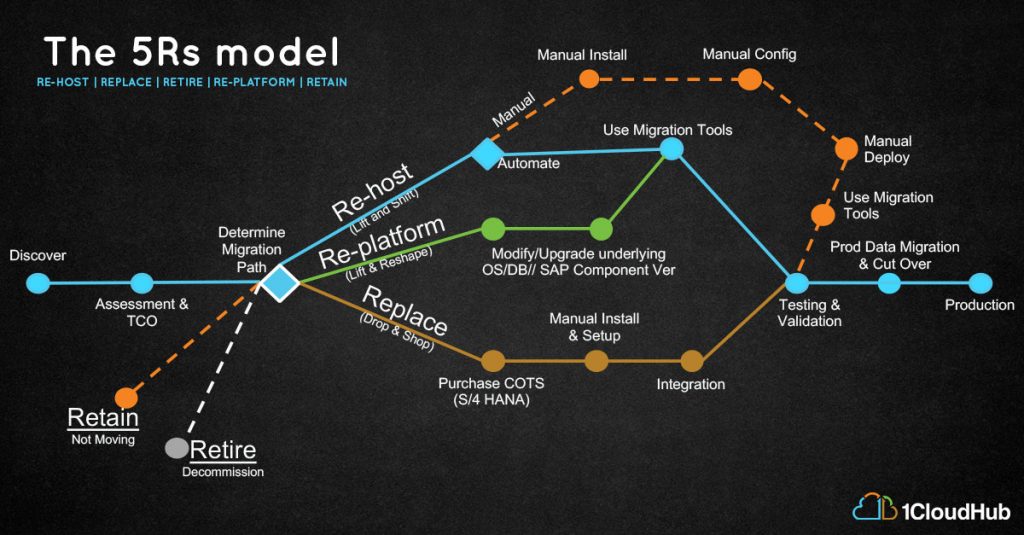Gone is the time when enterprises would consider: Do we really need to move SAP to the cloud? With the increased understanding of the advantages of cloud, the question today is: When are we migrating SAP to the cloud, how are we going to do it? And who can help us do it efficiently?
Well, we can help. Our dedicated SAP practice armed with the time-tested Nimbus framework, clearly defined process and extensive domain knowledge can help you in every step of your cloud journey. So that your seemingly daunting task of migrating your SAP ERP to the cloud would be a walk in the park.
Begin at the heart of the matter
As the first step, it is crucial to understand cost implications moving to the cloud. This would vary depending on your current situation. Are you close to your hardware refresh? Are you considering SAP upgrade or moving into either SAP on HANA or S4/HANA or moving out of SAP platform soon?
For instance, you can avoid capital expenditure (CapEx) by moving to the cloud when you are close to hardware refresh. Especially when you are not sure how long you plan to continue in this SAP version.
If you plan to upgrade or move into S4/HANA, instead of investing CapEx for all the hardware right up front, you must consider cloud. Because, implementing on-premises would mean that most of your hardware would be waiting for utilization for the whole implementation project, which usually runs close to a year. Typically, this would translate to a loss 1/4th of its total value even before business teams start using them. Instead, we could leverage cloud which helps to get the required capacity just in time and thus resulting in a considerable saving.
For a business-critical, enterprise-wide application like an ERP, this would be a critical step. The value of moving to the cloud isn’t just to save cost — which it will — in addition it also provides operational flexibility and overall agility to cater to dynamic business needs.
Assessment and discovery
Logical next step would be a thorough assessment of all application components, infrastructure readiness and feasibility of the migration process. To do this, the 1CloudHub team begins by collecting all landscape environment asset details including SAPS and IOPS requirements. It is this information that would later enable the building of an equivalent SAP certified right sized instance.
Following this is the discovery — data size, possibilities of housekeeping of the system, integration points and their nature of integration like webservice based, file-folder based or database level.
This will play an important role in building the migration path, the fundamental structure of your application migration. Strategic planning will ensure all applications and infrastructure elements respond positively to the migration.
The 5Rs model
A robust migration path follows 5Rs — Re-host, Replace, Retire, Re-platform, Retain — with each data or application element taking the scenic route that is most appropriate.
Re-host
Rehost or “lift and shift” methodology is the most common migration technique given its speed, simplicity, and cost optimization. It involves simple migration copying applications and data bits from outside into the cloud without modifying the code. This is easily done with some automation, migration tools and testing to validate successful completion for the production environment.
Re-place
Re-place, also known as “drop and shop” method involves replacing parts of your existing application with a more cloud-appropriate alternative. Sometimes, this could also mean moving to a different product altogether — purchasing COTS (s/4 HANA) — followed by a manual install, setup and integration.
Retire
Retire or “decommission” as an approach involves getting rid of the IT processes that are no longer useful and can be simply turned off. From the discovery and assessment, this should become quite obvious. As we prioritize applications based on their usability, we also identify processes that are not being used but add up in cost and resource allocation, which are best decommissioned.
Re-platform
Re-platform, also called “lift and reshape” is a much slower migration process. It involves modifying or upgrading the underlying operating system/ database/ SAP component versions to make the application cloud compatible. This also validates performance boosting confidence among business users as we are re-platforming the application.
Retain
Retain or simply “not moving” is for applications that are incompatible with the cloud environment. These applications are thus retained in the present state to be reconsidered later.
Whatever the route each of these application components take, they all meet again at the beautiful port of testing and validation. To ensure top notch performance of a business-critical application like SAP, it is imperative that a thorough quality control is put in place. Once all parties are happy, data is migrated to production and cut over is executed.
As simple as it seems, the Nimbus migration framework is a time-tested model that has helped billion dollar conglomerates across the globe achieve SAP cloud migration success. Take our logistics clients, for instance. A premier client of 1CloudHub, one of the world’s top three shipping companies with a revenue of over $20 billion needed their SAP CRM — the foundation of all customer support functions across countries — moved to cloud. They aspired for the scalability that cloud offered, to fuel their business growth.
Applying the Nimbus framework for this migration, we enabled 3x capacity with a flexible OpEx model, significantly optimising their total cost of ownership (TCO). More about this client’s success is in the case study here.
While each organization can put together a team to implement its own cloud migration, the nitty-gritty complexities of an application like SAP is best managed by an expert partner. Even better would be one who has industry experience, a work portfolio that speaks for itself, and who understands your enterprise’s challenges and needs.
For more about choosing the right cloud migration partner, read this blog post. To gauge if 1CloudHub is a right fit for you, speak to our cloud consultant today.

